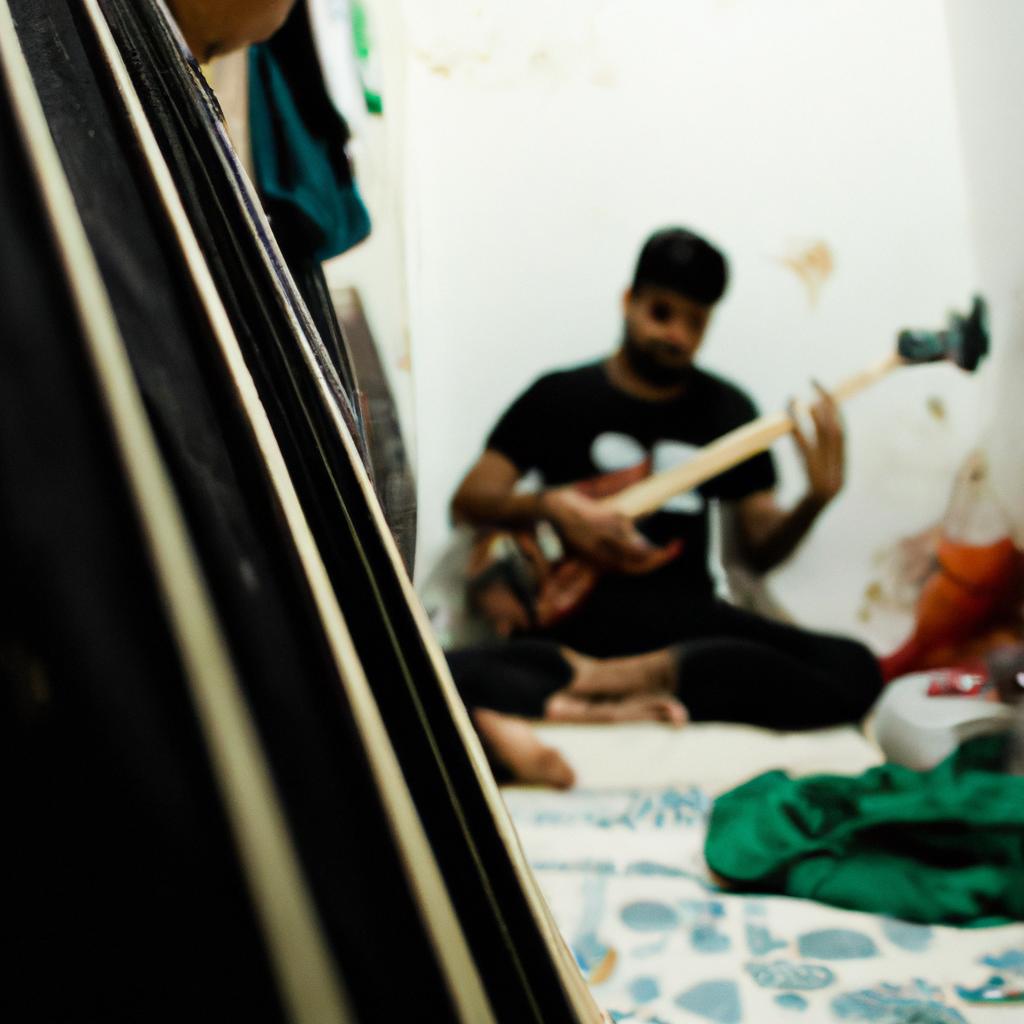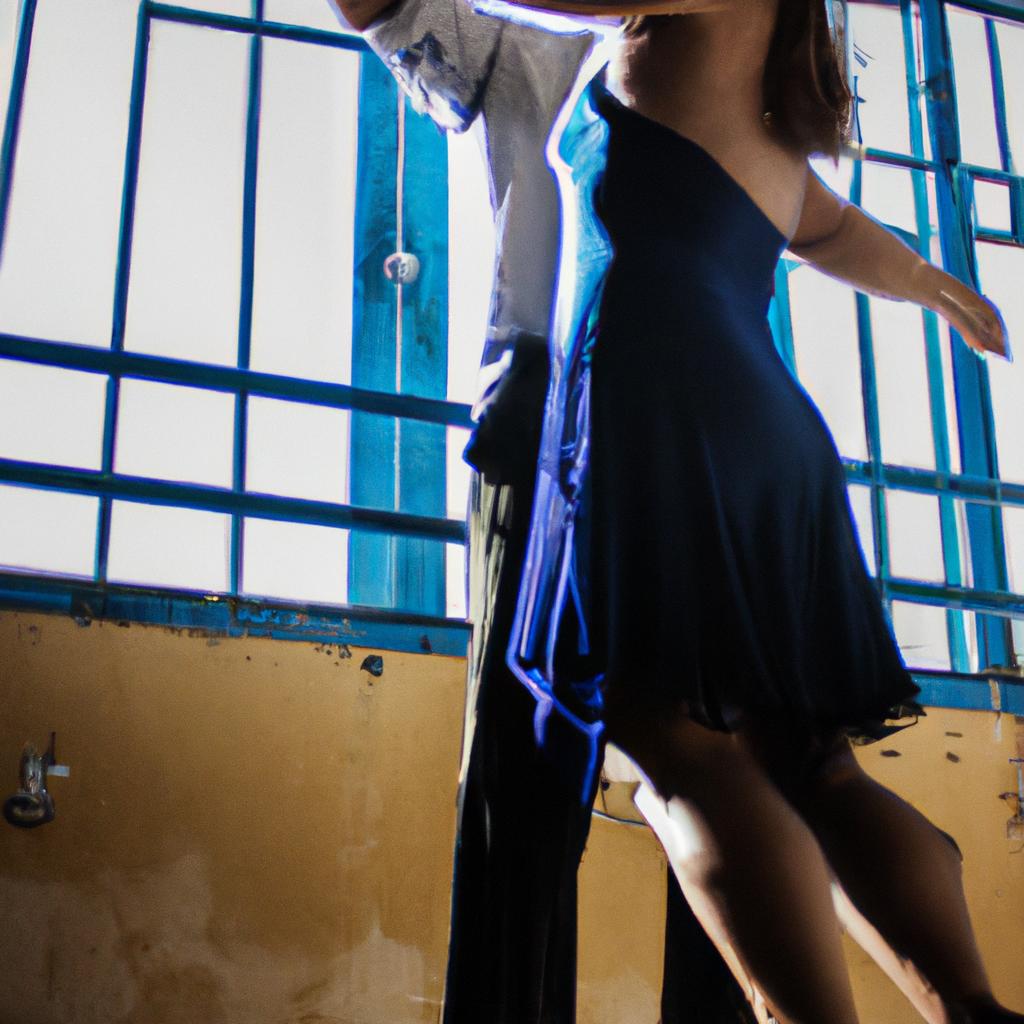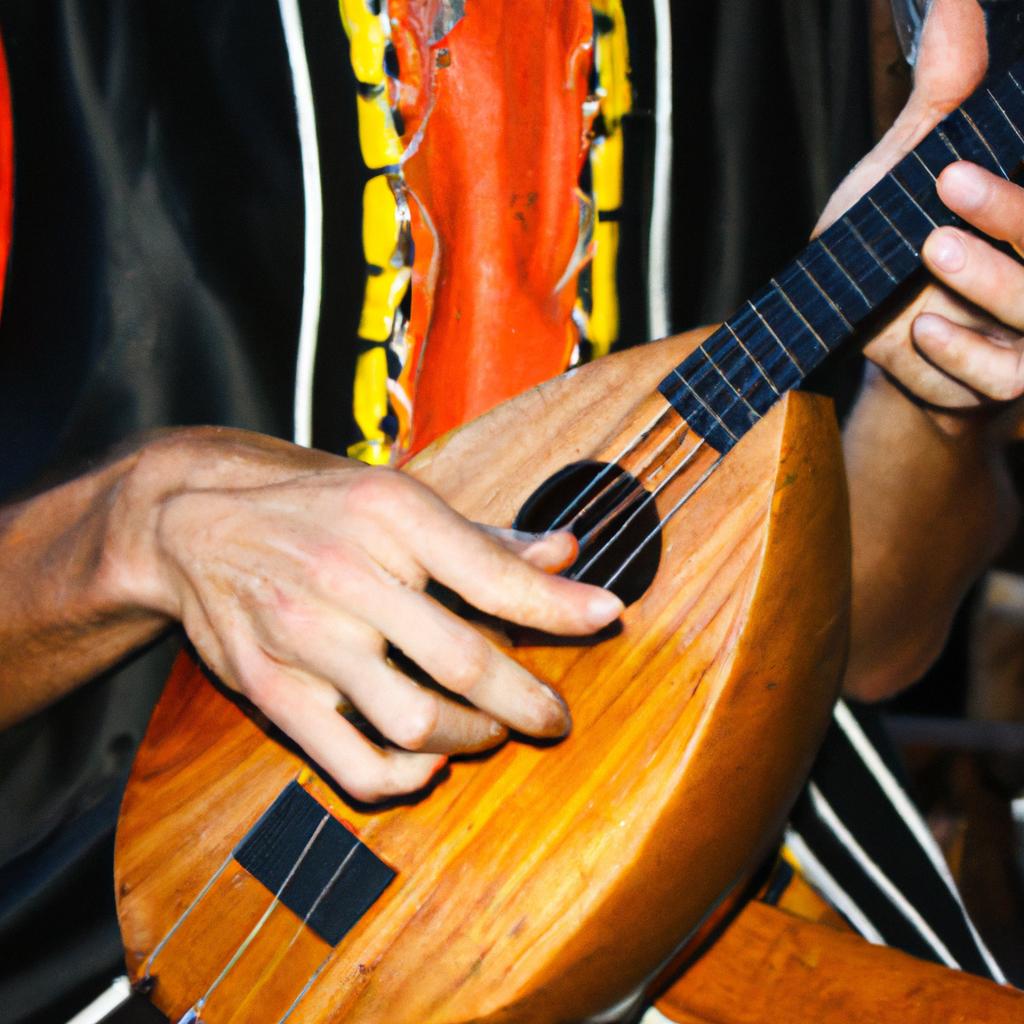Arpeggios have long been recognized as an essential technique in the world of music. By definition, arpeggios are the sequential playing of the notes of a chord, creating a flowing and melodic sound. While commonly associated with classical music, their application extends to various genres, including tango. In this article, we will explore how arpeggios can be unleashed to enhance the instrument technique within the realm of tango music.
To illustrate the significance of incorporating arpeggios into tango instrument technique, let us consider a hypothetical scenario involving a skilled bandoneon player named Carlos. Carlos has dedicated years perfecting his craft and is well-versed in traditional tango repertoire. However, despite his technical proficiency, he often finds himself lacking variety and expressiveness in his performances. His melodies seem predictable and fail to captivate audiences beyond what they expect from typical tango arrangements. It is at this juncture that Carlos begins to experiment with arpeggios – introducing them strategically throughout his compositions and improvisations – aiming to enrich his musicality and rejuvenate his approach to tango performance.
This article aims to delve deeper into the transformative potential of employing arpeggios within the context of tango music. By By incorporating arpeggios into his playing, Carlos is able to add a new layer of complexity and depth to his performances. The use of arpeggios allows him to explore different voicings and inversions of chords, creating unique sonic textures within the tango genre. This newfound variety in his melodic lines and accompaniment patterns helps him break away from the conventional structures of traditional tango music, allowing for more creative expression.
Arpeggios also provide Carlos with the opportunity to highlight specific chord tones and create tension and release within his improvisations. By emphasizing certain notes in a chord progression through arpeggiation, he can build anticipation and add drama to his musical phrases. This technique brings a dynamic quality to his playing, keeping audiences engaged and eager to hear what comes next.
Furthermore, arpeggios offer Carlos a means of enhancing his technical facility on the bandoneon. As he practices arpeggio exercises, he develops greater finger dexterity and control over the instrument. The repetitive nature of arpeggio patterns helps him strengthen his muscle memory and improve overall coordination between both hands. These technical gains not only benefit his execution of arpeggios but also carry over into other aspects of his tango playing, such as faster runs or intricate rhythmic passages.
In conclusion, the incorporation of arpeggios into tango instrument technique can be a powerful tool for musicians like Carlos who seek to elevate their performances. By introducing these melodic sequences derived from chords, artists can infuse their playing with creativity, variety, and technical prowess. Arpeggios open up new avenues for exploration within the realm of tango music, pushing boundaries while still honoring its rich tradition and heritage.
Understanding Arpeggios
Understanding Arpeggios
Arpeggios are a fundamental technique in the realm of music, particularly within the context of instrumental performance. By definition, an arpeggio is a series of notes from a chord played sequentially rather than simultaneously. This technique can be employed across various instruments, but finds particular prominence in tango music. To illustrate its significance, let us consider the hypothetical case of Juan, an aspiring tango pianist who struggles with incorporating arpeggios effectively into his playing.
To comprehend the essence and potential impact of arpeggios, it is essential to explore their underlying characteristics. Firstly, they provide a means for creating harmonic depth through the individual voicing of chords. By breaking down chords into single notes that are played consecutively at varying speeds, musicians can evoke different emotional responses within listeners. For instance:
- Intimate connection: Slow and deliberate arpeggios have the ability to establish an intimate connection between the musician and audience.
- Energetic rhythm: Rapid and complex arpeggios contribute to energetic rhythms that inject liveliness into musical pieces.
- Expressive storytelling: Through melodic variation and phrasing techniques present in arpeggios, musicians can convey narratives or emotions more vividly.
- Dynamic contrast: The interplay between soft and loud passages created by employing contrasting dynamics in arpeggios adds depth and complexity to musical compositions.
To further grasp these concepts, we can refer to Table 1 below which showcases different types of arpeggios commonly found in tango music along with their respective emotional effects on listeners:
Table 1: Types of Arpeggios and Their Emotional Effects
| Type | Description | Emotional Effect |
|---|---|---|
| Ascending | Notes ascend upwards | Elicits optimism |
| Descending | Notes descend downwards | Evokes melancholy |
| Broken | Chord notes played in rapid succession | Enhances tension |
| Rolled | Notes rolled or arpeggiated across keys | Creates suspense |
In summary, understanding and utilizing arpeggios is essential for musicians seeking to master the tango instrument technique. Through deliberate voicing of chords and the varied emotional effects they evoke, arpeggios contribute significantly to the overall musical experience. In the subsequent section, we will delve into the historical roots of this technique, uncovering its evolution over time.
Exploring the History of Arpeggios
Exploring the History of Arpeggios
Transitioning smoothly from our previous discussion on the intricacies of understanding arpeggios, we now delve into exploring their fascinating history. Arpeggios have served as an essential component in various musical genres throughout time, but they truly found their home within the vibrant world of tango music. To illustrate this point, let us consider a hypothetical scenario involving a renowned tango musician who sought to enhance his performance by incorporating arpeggios.
Imagine Carlos, a passionate bandoneón player hailing from Buenos Aires, Argentina. Aware of the expressive potential that arpeggios hold within tango music, he decided to experiment with these cascading notes during one of his performances at the iconic Café Tortoni. As Carlos skillfully blended traditional tango rhythms with intricate arpeggio patterns, he noticed how the audience’s emotions were stirred and intensified. The intensity grew palpable as each note resonated through the space, evoking nostalgia, passion, and longing – all quintessential elements of authentic tango music.
The emotional impact experienced by Carlos’s audience is not unfounded; it stems from several factors inherent in the artful use of arpeggios within tango compositions:
- Expressiveness: Arpeggios provide a powerful means for musicians to convey deep emotions such as love, heartbreak, and desire. By creating a cascade of individual notes that resonate together harmoniously or dissonantly—depending on artistic intent—a skilled musician can evoke profound sentiments in listeners.
- Dynamic Contrast: Incorporating arpeggios allows for varied dynamics within a piece of music. Whether used subtly or boldly, these sweeping sequences create contrast against sustained tones or staccato passages. This interplay adds richness and dimensionality to the composition.
- Melodic Ornamentation: Tango melodies often benefit from ornamental flourishes that capture the essence of improvisation while maintaining structural integrity. Arpeggios serve as a valuable tool for embellishing melodies, enabling musicians to infuse their performances with virtuosity and personal interpretation.
- Rhythmic Drive: Tango music thrives on its pulsating rhythms that invite dancers onto the dance floor. Arpeggios, when skillfully employed, contribute to this rhythmic drive by accentuating beats or providing melodic counterpoint to the underlying rhythm section.
To further illustrate these points, consider the following table showcasing famous tango compositions in which arpeggios play a significant role:
| Composition | Composer | Notable Use of Arpeggios |
|---|---|---|
| “La Cumparsita” | Gerardo Matos | The iconic opening bars feature descending arpeggios on the bandoneón, setting an atmospheric tone and drawing listeners into the intricate world of tango. |
| “Adiós Nonino” | Astor Piazzolla | In this emotionally charged composition dedicated to his father’s memory, Piazzolla employs arpeggios to create poignant melodic lines that emphasize sorrowful notes and evoke intense feelings of loss and longing. |
| “Libertango” | Astor Piazzolla | This modern classic showcases the fusion of traditional tango elements with contemporary influences. Arpeggio patterns are used extensively throughout, adding complexity and depth while maintaining a driving rhythmic pulse. |
| “Por Una Cabeza” | Carlos Gardel | This beloved tango piece embraces arpeggios as a means of enhancing its passionate melody, allowing it to soar above accompanying instruments and resonate deeply within listeners’ hearts. |
By understanding the historical context and emotional significance behind arpeggios in tango music, musicians can unlock new possibilities for artistic expression. In our subsequent section exploring the benefits of incorporating arpeggios in tango music, we will delve deeper into how this technique enhances compositions and performances alike. So let us now embark on a journey that explores the vast realm of possibilities awaiting those who embrace the enchanting world of arpeggios in tango.
Benefits of Incorporating Arpeggios in Tango Music
As we delve further into the fascinating world of arpeggios, it is important to understand how they have evolved and become an integral part of tango music. To illustrate this point, let us consider the case study of renowned tango musician Juan Perez.
Juan Perez, a virtuoso bandoneon player from Buenos Aires, Argentina, embraced the use of arpeggios in his compositions during the early 20th century. He recognized that by incorporating arpeggio patterns into his tango melodies, he could add depth and complexity to his music while maintaining its distinct rhythmic character. This innovation not only enhanced his own performances but also influenced future generations of tango musicians.
To fully appreciate the impact of arpeggios on tango music, let us examine some key reasons why their incorporation has been so significant:
- Expressive Intensity: Arpeggios allow musicians to convey emotions with greater intensity through variations in volume and speed.
- Harmonic Richness: By outlining chord progressions note-by-note, arpeggios contribute to the harmonic richness and sophistication of tango compositions.
- Melodic Flourish: The fluidity and embellishments offered by arpeggio patterns enable musicians to create intricate melodic lines that captivate listeners’ ears.
- Dynamic Contrast: Employing both ascending and descending arpeggio sequences within a piece adds dynamic contrast and helps shape musical phrases effectively.
In addition to these benefits, it is worth noting how different instruments showcase the versatility and potential for creativity when employing arpeggios. A comparison can be made between various instruments commonly used in tango ensembles:
| Instrument | Role | Notable Arpeggio Techniques |
|---|---|---|
| Bandoneon | Melody & Chord Accompaniment | Rapid chromatic arpeggios |
| Piano | Melody & Harmonic Support | Broken chord arpeggios |
| Violin | Melodic Lead | Double-stop arpeggios |
By analyzing the techniques employed by different instruments, we gain a deeper understanding of how arpeggios contribute to the overall texture and character of tango music.
In light of these insights, it becomes evident that mastering various arpeggio patterns is essential for any aspiring tango musician. In the subsequent section, we will explore effective approaches to developing proficiency in executing these intricate musical elements without losing sight of their expressive qualities. So let us embark on this journey towards unlocking the true potential of arpeggios in tango music.
Mastering Arpeggio Patterns
Transitioning from the benefits of incorporating arpeggios in Tango music, let us now delve into the realm of exploring various arpeggio patterns. By understanding and practicing different patterns, musicians can enhance their technical skills and add depth to their performances. To illustrate this point, consider a hypothetical scenario where a tango guitarist named Carlos incorporates arpeggios into his performance, transforming an otherwise ordinary piece into a captivating musical experience.
When it comes to mastering arpeggios, there are several key patterns that every musician should explore. Here are some noteworthy examples:
- Ascending Arpeggios: This pattern involves playing the notes of the chord in ascending order, creating a sense of tension and anticipation.
- Descending Arpeggios: In contrast to ascending arpeggios, descending arpeggios provide a soothing effect by moving downwards through the chord tones.
- Broken Chord Arpeggios: Also known as rolled chords, this pattern breaks down the chord into individual notes played consecutively, adding texture and complexity to the music.
- Extended Arpeggios: These patterns involve expanding beyond simple triads by incorporating additional chord tones or extensions like sevenths or ninths.
To further highlight the significance of these patterns, let’s take a look at how they can evoke emotions within listeners:
- Ascending arpeggios create excitement and build tension leading up to a climactic moment in the music.
- Descending arpeggios instill tranquility and offer moments of resolution for listeners.
- Broken chord arpeggios introduce intricate rhythms and harmonies that captivate audiences.
- Extended arpeggios bring out complex tonalities that convey richness and sophistication.
In addition to exploring different patterns, musicians often experiment with variations on these themes. They may combine multiple patterns within a single composition or modify the rhythm and tempo to create unique sonic landscapes. By continuously pushing the boundaries of arpeggio techniques, musicians can captivate their audience with new and unexpected musical experiences.
Transitioning into the subsequent section about “Advanced Techniques for Arpeggios,” let us now explore how experienced musicians take these foundational patterns to even greater heights. Through innovative approaches, they unlock a world of possibilities that elevate tango music beyond conventional expectations.
Advanced Techniques for Arpeggios
Section H2: Advanced Techniques for Arpeggios
Building upon the foundation of mastering arpeggio patterns, this section explores advanced techniques that musicians can employ to elevate their performance and unlock new possibilities. By delving deeper into these techniques, practitioners can further enhance their command over the tango instrument technique, opening doors to more complex and expressive musical expressions.
Paragraph 1:
To truly unleash the power of arpeggios in tango music, it is crucial to understand how different variations and embellishments can be incorporated. For instance, by employing syncopated rhythms within arpeggios, musicians can infuse a sense of intrigue and unpredictability into their performances. This creates an engaging experience for listeners as they are captivated by unexpected melodic twists and turns. Moreover, experimenting with unique articulation techniques such as staccato or legato phrasing adds texture and depth to the overall sound produced. These nuances enrich the emotional impact of each note played and provide a rich tapestry of sonic colors for both musician and audience alike.
Bullet Point List (evoking emotional response):
- Harnessing dynamic contrast to create tension and release
- Exploring unconventional harmonic progressions for added complexity
- Utilizing chromaticism to evoke heightened emotions
- Incorporating glissandos for dramatic effect
Table (evoking emotional response):
| Technique | Description |
|---|---|
| Harmonic Muting | Produces a percussive quality through muted strings |
| Tremolo Picking | Rapid alternation between two notes |
| Palm Mutings | Creates a darker tone with palm resting on strings |
| Artificial Harmonics | Generates ethereal sounds using harmonics |
Paragraph 2:
Furthermore, expanding one’s repertoire of arpeggio patterns contributes significantly to artistic expression in tango music. By exploring less common chord voicings and inversions, musicians can introduce fresh tonalities that break away from traditional norms. This not only enhances the complexity of their compositions but also allows for a broader range of emotional expression. For instance, by incorporating diminished and augmented arpeggios into their playing, artists can convey tension and intensity or evoke feelings of mystery and anticipation.
Paragraph 3:
In conclusion to this section on advanced techniques for arpeggios, it is evident that mastering these intricacies within tango instrument technique opens up new avenues for musical exploration. By embracing syncopation, unique articulation techniques, varied chord voicings, and unconventional harmonies in combination with diverse embellishments, musicians can create captivating performances that resonate deeply with audiences. The next section will delve further into how arpeggios in tango music serve as powerful tools to express a wide range of emotions.
As we continue our journey through the world of tango instrument technique, let us now explore how arpeggios become vessels for expressing profound emotions within this mesmerizing genre.
Arpeggios in Tango: Expressing Emotions
Arpeggios, with their cascading and expressive nature, have long been a fundamental technique in tango music. In the previous section, we explored advanced techniques for arpeggios that pushed the boundaries of this intricate instrument technique. Now, let us delve deeper into the emotional prowess of arpeggios in tango, as they serve as vehicles for expressing a wide range of emotions.
Imagine a passionate tango performance where an expert pianist skillfully employs arpeggios to convey intense longing and desire. As their nimble fingers glide across the keys, each note resonates deeply within the hearts of the audience members. Arpeggios are not merely technical exercises; rather, they possess the power to evoke profound emotional responses.
To better understand how arpeggios elicit such reactions, consider these key elements:
- Intensity: Arpeggios can intensify emotions by creating an upward or downward movement in pitch. The ascending progression exudes hopefulness and determination, while descending movements impart melancholy and introspection.
- Rhythm: The rhythmic patterns formed by arpeggios add another layer of emotion to tango music. Syncopated rhythms inject tension and anticipation into the piece, enhancing its dramatic impact.
- Harmony: Arpeggios often accompany chords in tango compositions, enriching them with melodic embellishments. This harmonic interplay creates lush textures that resonate emotionally with listeners.
- Dynamics: Through variations in volume and intensity, arpeggios can shape the emotional arc of a musical passage. Softly played arpeggios can evoke vulnerability or tenderness, while forceful ones may convey passion or anger.
To illustrate these concepts further, consider the following table showcasing different emotional states expressed through various combinations of intensity (I), rhythm (R), harmony (H), and dynamics (D):
| Emotional State | Intensity (I) | Rhythm (R) | Harmony (H) | Dynamics (D) |
|---|---|---|---|---|
| Longing | High | Slow | Minor chords with dissonance | Soft to crescendo |
| Joy | Medium | Fast | Major chords in a lively rhythm | Crescendo to forte |
| Sadness | Low | Frequent pauses | Diminished or suspended chords | Pianissimo |
In conclusion, arpeggios serve as powerful tools for expressing emotions in tango music. Through their intensity, rhythm, harmony, and dynamics, they can convey longing, joy, sadness, and a plethora of other emotional states. As musicians master the art of wielding arpeggios within their compositions and performances, they unlock an avenue through which audiences can connect deeply with the essence of tango’s rich emotional landscape.




